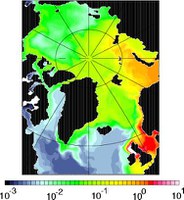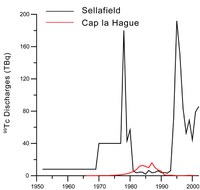RADNOR
Summary
Radioactivity in the Arctic is a central topic within environmental pollution issues (see e.g. link to AMAP below). Sources, both actual and potential, for radioactive pollution in the Arctic are marine and atmospheric long-range transported radionuclides, originating from nuclear power and reprocessing plants (e.g. Sellafield and La Hague), dumped radioactive waste, accidents with nuclear powered or armed ships and submarines and global fallout from nuclear test explosions in the atmosphere. Technetium-99 (99Tc), a highly soluble, beta-radiation emitting man-made radionuclide (half life: 2.13.105 yrs.) is one of these polluting substances. Since 1994, enhanced amounts of it were discharged at the Sellafield nuclear reprocessing plant in the U.K.. to estimate the effect of such radionuclides on the environment, including man and biota, dose assessment models are used, one of which is the NRPA box model. It includes numerous features describing the behaviour of radionuclides. RADNOR aims at improving the abilities of this box model further.
 |
 |
| Simulated surface concentration of the radionuclide 99Tc (Bq/m3) in August 2002. | Releasefunction for 99Tc from Sellafield and La Hague facilities (source: NRPA) |
Principal objective of RADNOR:
To further constrain radioactive dose assessments for the Nordic marine environment.
To be accomplished through:
1) The determination of levels and time series of 99Tc in benthic and pelagic food webs.
2) Improvements to the understanding of site-specific and time-dependent sediment-water interactions (Kd), kinetics of accumulation (CF) and body distribution in marine organisms.
3) Improvement of the NRPA box model by the statistical analysis of NAOSIM model hindcasts for 99Tc dispersion, the introduction of selectable flow fields and novel and reassessed abiotic and biotic parameters.
OASys is involved into the 3rd task which consists of several subtasks:
· To run hindcasts of the 99Tc dispersion in the Ocean for the period 1970 to present with the NAOSIM circulation model and the NRPA box model
· To set up a 99Tc database which gathers all available historical and modern 99Tc sample analyses
· To perform an intercomparison exercise between model results and the observational 99Tc database
· To perform a statistical analysis of flow patterns with the NAOSIM for the period 1948 to present, and to use the dominant patterns as forcing fields to run the NRPA box model in different circulation states.
· To further improve the NRPA box model by the incorporation of novel and re-assessed Kd and CF values generated through RADNOR field and laboratory studies.
Participants:
NRPA – Justin Gwynn, Mikhail Iosjpe, Justin Brown
O.A.Sys. – Michael Karcher
AWI – Rüdiger Gerdes
NPI – Sebastian Gerland, Vladimir Pavlov
IFM Univ.Hamburg – Ingo Harms
AUN – Brit Salbu
IMR – Hilde Elise Heldal
Part of the modelling work has been utilized in the AMAP (Arctic Monitoring and Assassment) Report on Radioactivity in the Arctic 2002 which apeard 2004.
RADNOR is funded by the Norsk Forskningsradet (Norwegian Research Council) for the period 2003 to 2005.
Related References
-
Dowdall, M, Gerland, S, Karcher, M, Gwynn, JP, Rudjord, AL, and Olstad, AK (2005).
Optimization of sampling for the temporal monitoring of Technetium-99 in the Arctic marine environment
Journal of Environmental Radioactivity 84(1):111-130. -
Karcher, M, Gerland, S, Harms, IH, Iosjpe, M, Heldal, HE, Kershaw, PJ, and Sickel, M (2004).
The dispersion of Technetium-99 in the Nordic Seas and the Arctic Ocean: a comparison of model results and observations
Journal of Environmental Radioactivity 74(1-3):185-198. -
Gerland, S, Lind, B, Dowdall, M, and Kolstad, MK (2003).
Technetium-99 in seawater in the West Spitsbergen Current and adjacent areas
Journal of Environmental Radioactivity 69(1-2):119-127. -
Harms, I, Harms, IH, Karcher, M, and Burchard, H (2003).
The use of hydrodynamic circulation models for simulating oceanic dispersion of radioactivity
In: Modelling Radioactivity in the Environment, edited by M.Scott. Elsevier, chapter 3, pages 55-86. -
Harms, IH, and Karcher, M (2003).
Pathways of anthropogenic radionuclides in the northern oceans
In: Modelling Radioactivity in the Environment, edited by M. Scott. Elsevier, chapter 10, pages 287-314. -
Gerdes, R, Karcher, M, Kauker, F, and Köberle, C (2001).
Predicting the spread of radioactive substances from Kursk
EOS 82(23):253, 256-257. -
Dethleff, D, Nies, H, Harms, IH, and Karcher, M (2000).
Dispersal of particle-bond and dissolved radionuclides through flaw lead produced sea-ice and dense water in the western Kara Sea
Journal of Marine Systems 24(3-4):233-248. -
Harms, IH, Karcher, M, and Dethleff, D (2000).
Modelling Siberian river runoff - implications for contaminant transport in the Arctic Ocean
Journal of Marine Systems 27:95-115. -
Nies, H, Harms, IH, Karcher, M, Dethleff, D, and Bahe, C (1999).
Anthropogenic Radioactivity in the Arctic Ocean - Review of the results from the Joint German project
Science of the Total Environment 237/238:181-191. -
Nies, H, Harms, IH, Karcher, M, Dethleff, D, Bahe, C, Kuhlman, G, Kleine, E, Löwe, P, Oberhuber, JM, Matishov, D, Stepanov, A, and Vasiliev, OF (1998).
Anthropogenic radioactivity in the Nordic Seas and the Arctic Ocean: Results from a joint project
Deutsche Hydrographische Zeitschrift 50(4):313-343.
Attachments
Click here for attachment folder.
